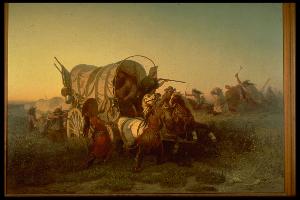Charles Ferdinand Wimar
Karl Ferdinand Wimar;Charles Ferdinand Wimar
Place: Siegburg
Born: 1828
Death: 1862
Biography:
Early Life and Artistic Pursuits
Charles Ferdinand Wimar, also known as Karl Ferdinand Wimar or Carl Wimar, was a German-American painter born in Siegburg, Germany in 1828. He immigrated to the United States with his family at the age of 15 and settled in St. Louis, Missouri. Wimar began studying painting with Leon Pomarede in 1846 and later traveled up the Mississippi River.
Artistic Influences and Notable Works
Wimar's style was significantly influenced by his time at the Düsseldorf Academy, where he studied with Emanuel Leutze. This period is evident in his works, such as The Abduction of Boone's Daughter by the Indians (1855-1856), depicting a colonial incident near Boonesborough, Kentucky.
- The Attack on an Emigrant Train (University of Michigan Museum of Art, Oil On Canvas) showcases Wimar's skill in capturing dramatic scenes.
- Wimar's work is also featured in the The Saint Louis Art Museum, a cultural gem in the heart of America, which houses an impressive collection of artworks from various periods and regions.
Later Life and Contributions to American Art
Wimar made two long trips up the Missouri River in 1858 and 1859, and painted murals in the Rotunda of the St. Louis Court House in 1861. His contributions to American art are notable for capturing the essence of Native Americans in the West and the great herds of buffalo. Notable Works:
- Explore more of Wimar's works on Wikioo.org
- Discover the Kunstsammlungen Und Museen Augsburg, a cultural treasure in Augsburg, Germany, featuring an impressive collection of artworks from various periods.
Legacy and Remembrance
Charles Ferdinand Wimar passed away in St. Louis in 1862, leaving behind a legacy of art that continues to inspire and educate. His life's work is a testament to the enduring power of art in capturing the essence of a bygone era.


